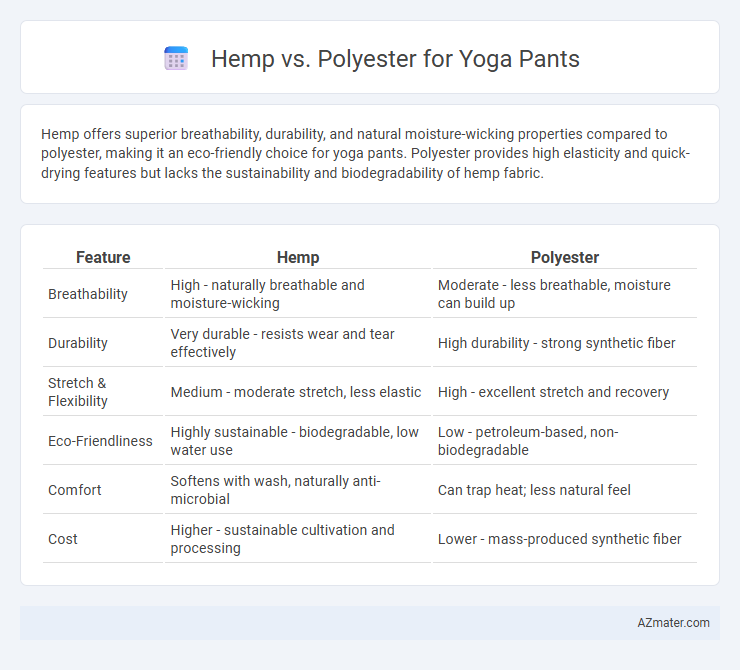Hemp offers superior breathability, durability, and natural moisture-wicking properties compared to polyester, making it an eco-friendly choice for yoga pants. Polyester provides high elasticity and quick-drying features but lacks the sustainability and biodegradability of hemp fabric.
Table of Comparison
| Feature | Hemp | Polyester |
|---|---|---|
| Breathability | High - naturally breathable and moisture-wicking | Moderate - less breathable, moisture can build up |
| Durability | Very durable - resists wear and tear effectively | High durability - strong synthetic fiber |
| Stretch & Flexibility | Medium - moderate stretch, less elastic | High - excellent stretch and recovery |
| Eco-Friendliness | Highly sustainable - biodegradable, low water use | Low - petroleum-based, non-biodegradable |
| Comfort | Softens with wash, naturally anti-microbial | Can trap heat; less natural feel |
| Cost | Higher - sustainable cultivation and processing | Lower - mass-produced synthetic fiber |
Introduction: Why Fabric Choice Matters for Yoga Pants
Choosing the right fabric for yoga pants directly impacts comfort, breathability, and flexibility essential for optimal performance and practice. Hemp offers natural moisture-wicking, durability, and eco-friendly benefits, while polyester provides lightweight stretch, quick-drying properties, and high elasticity. Understanding these material characteristics ensures selecting yoga pants that support movement and enhance overall workout experience.
Overview of Hemp and Polyester Materials
Hemp fabric is derived from the fibers of the Cannabis sativa plant, known for its durability, breathability, and natural antimicrobial properties, making it ideal for activewear like yoga pants. Polyester, a synthetic polymer made from petroleum-based products, offers excellent moisture-wicking, wrinkle resistance, and quick-drying capabilities commonly used in athletic apparel. Hemp provides a sustainable and biodegradable option with a soft, breathable texture, while polyester excels in elasticity and long-lasting shape retention.
Sustainability: Hemp vs Polyester
Hemp offers superior sustainability compared to polyester for yoga pants due to its rapid growth rate, low water usage, and biodegradability, significantly reducing environmental impact. Polyester, derived from petroleum, involves high energy consumption and contributes to microplastic pollution, making it less eco-friendly. Choosing hemp not only supports regenerative agriculture but also minimizes carbon footprint and textile waste in the activewear industry.
Comfort and Breathability Comparison
Hemp yoga pants offer superior breathability and moisture-wicking properties due to their natural fibers, ensuring better ventilation and reduced sweat retention during intense workouts. Polyester, while durable and flexible, tends to trap heat and moisture, which may cause discomfort and inhibit airflow in comparison to hemp. The hypoallergenic and antimicrobial qualities of hemp further enhance comfort, making it a preferred choice for those prioritizing skin-friendly, breathable activewear.
Durability and Longevity
Hemp yoga pants offer superior durability due to their natural fibers, which are resistant to wear, stretching, and pilling, making them ideal for long-term use. Polyester, while durable and resistant to shrinking and wrinkles, tends to degrade faster under intense physical activity and frequent washing. The biodegradable nature of hemp also ensures longevity without compromising environmental impact, unlike synthetic polyester fibers that may break down into microplastics.
Moisture-Wicking and Odor Resistance
Hemp yoga pants offer superior moisture-wicking properties due to their natural fibers that efficiently absorb and evaporate sweat, keeping the skin dry during intense workouts. Polyester fabric also provides excellent moisture-wicking capabilities but tends to retain odors more than hemp, which has inherent antimicrobial properties that naturally resist odor buildup. Choosing hemp over polyester ensures better breathability and lasting freshness, making it ideal for yoga practitioners seeking comfort and hygiene.
Stretch and Flexibility
Hemp yoga pants offer natural breathability and moderate stretch, enhanced by blends with spandex or elastane to improve flexibility and comfort during movement. Polyester fabric provides superior stretch and quick recovery, delivering excellent flexibility and durability for intense yoga sessions. Blended fabrics combining hemp's eco-friendliness with polyester's elasticity create optimized performance wear balancing sustainability and stretchability.
Environmental Impact and Biodegradability
Hemp yoga pants offer a significantly lower environmental impact compared to polyester, as hemp cultivation requires minimal water, no pesticides, and enhances soil health, while polyester production relies on petroleum, a non-renewable resource with high carbon emissions. Biodegradability is another key factor; hemp fabric naturally decomposes within months in soil, reducing landfill waste and microplastic pollution, whereas polyester can take hundreds of years to break down and often sheds synthetic microfibers harmful to marine ecosystems. Choosing hemp over polyester supports sustainable fashion by reducing ecological footprints and promoting organic fiber cycles.
Price and Accessibility
Hemp yoga pants tend to be pricier than polyester options due to the sustainable cultivation and eco-friendly processing methods involved in hemp fiber production. Polyester yoga pants, made from synthetic materials, are generally more affordable and widely available in mainstream retail stores and online marketplaces. The higher accessibility and lower price of polyester make it a popular choice, whereas hemp offers a niche market appeal with its natural, biodegradable attributes.
Conclusion: Which Fabric is Best for Yoga Pants?
Hemp offers exceptional breathability, durability, and natural antibacterial properties that enhance comfort and sustainability in yoga pants. Polyester excels in moisture-wicking abilities and stretch, providing a supportive fit for intensive workouts but may lack environmental benefits. Choosing hemp-based yoga pants is ideal for eco-conscious yogis seeking long-lasting, breathable wear, while polyester suits those prioritizing performance and elasticity.

Infographic: Hemp vs Polyester for Yoga Pant
 azmater.com
azmater.com